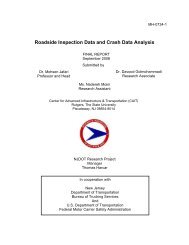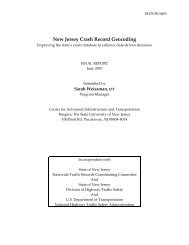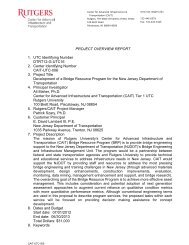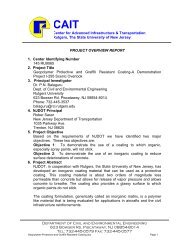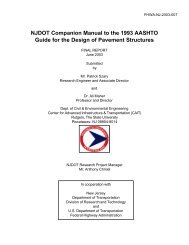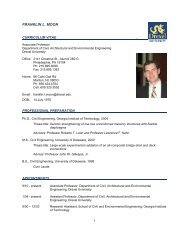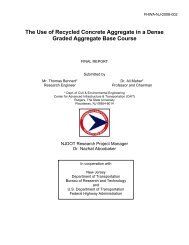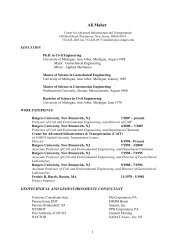Short Line Rail: Its Role in Intermodalism and Distribution
Short Line Rail: Its Role in Intermodalism and Distribution
Short Line Rail: Its Role in Intermodalism and Distribution
You also want an ePaper? Increase the reach of your titles
YUMPU automatically turns print PDFs into web optimized ePapers that Google loves.
P&W operates between 20 <strong>and</strong> 30 tra<strong>in</strong>s per day over its system. <strong>Its</strong> ma<strong>in</strong> yard,<br />
shops complex, <strong>and</strong> dispatcher are all located at Albany. Additional crew bases<br />
are <strong>in</strong> St. Helens, Oregon, Tigard, Oregon, McM<strong>in</strong>nville, Oregon, <strong>and</strong> Eugene,<br />
Oregon.<br />
In 2007-2008, the P&W l<strong>in</strong>e between Beaverton <strong>and</strong> Wilsonville, Oregon was<br />
purchased by Wash<strong>in</strong>gton County, Oregon <strong>and</strong> TriMet. It subsequently<br />
upgraded for use by commuter tra<strong>in</strong>s to be operated under the Westside Express<br />
Service, or WES, operat<strong>in</strong>g moniker.<br />
Upgrades to the route <strong>in</strong>cluded a new roadbed, ballast, ties <strong>and</strong> rail to<br />
accommodate passenger tra<strong>in</strong> speeds of 60 MPH <strong>and</strong> freight tra<strong>in</strong> speeds of 40<br />
MPH, Centralized Traffic Control signal<strong>in</strong>g, Automatic Tra<strong>in</strong> Stop at control<br />
po<strong>in</strong>ts, new sid<strong>in</strong>gs, station platforms at the end po<strong>in</strong>ts along with <strong>in</strong> Tigard,<br />
Oregon <strong>and</strong> Tualat<strong>in</strong>, Oregon, as well as a station <strong>in</strong> the Progress/Wash<strong>in</strong>gton<br />
Square area near the Beaverton/Tigard city l<strong>in</strong>e, <strong>and</strong> a ma<strong>in</strong>tenance shop<br />
located <strong>in</strong> Wilsonville (staffed by TriMet employees). P&W is responsible for tra<strong>in</strong><br />
operations, <strong>in</strong>clud<strong>in</strong>g staff<strong>in</strong>g the tra<strong>in</strong>s with an Eng<strong>in</strong>eer <strong>and</strong> Conductor,<br />
dispatch<strong>in</strong>g, <strong>and</strong> ma<strong>in</strong>tenance. TriMet has a Manager to oversee the service <strong>and</strong><br />
will h<strong>and</strong>le basic ma<strong>in</strong>tenance of the fleet.<br />
The service had been expected to launch as early as August 2008 but due to<br />
delays by the car manufacturer, Colorado <strong>Rail</strong>car, the actual start of service date<br />
was February 2, 2009. Four Colorado <strong>Rail</strong>car DMUs will be used, three of which<br />
are powered vehicles <strong>and</strong> can move on their own, <strong>and</strong> a fourth vehicle which is a<br />
trailer to be towed beh<strong>in</strong>d one of the three powered cars<br />
(http://en.wikipedia.org/wiki/Portl<strong>and</strong>_<strong>and</strong>_Western_<strong>Rail</strong>road).<br />
These four metropolitan areas, <strong>and</strong> the short l<strong>in</strong>e <strong>and</strong> regional railroads operat<strong>in</strong>g<br />
“with<strong>in</strong> the belt,” are illustrative of the differences between carriers, their customer bases<br />
<strong>and</strong> the environments with<strong>in</strong> which they operate. It should be no surprise that with over<br />
500 short l<strong>in</strong>e <strong>and</strong> regional railroads <strong>in</strong> the U.S., there would be substantial variation <strong>in</strong><br />
their profiles. However, with the exception of the FEC, most of the short l<strong>in</strong>es <strong>and</strong><br />
regional railroads <strong>in</strong> the U.S., <strong>and</strong> <strong>in</strong> the congested metropolitan areas, h<strong>and</strong>le a<br />
preponderant amount of manifest, or commodity-based carload traffic. As we look at<br />
possible roles that short l<strong>in</strong>e <strong>and</strong> regional railroads might play <strong>in</strong> reduc<strong>in</strong>g truck<br />
congestion issues <strong>in</strong> metropolitan areas, it is clear there will be no “one-size” fits all<br />
solution. It will be paramount to consider the “market” with<strong>in</strong> each of the metropolitan<br />
areas, i.e., the customer mix that exists, or could exist, “with<strong>in</strong> the belt,” the exist<strong>in</strong>g rail<br />
<strong>and</strong> yard <strong>in</strong>frastructure, as well as the opportunities for exp<strong>and</strong><strong>in</strong>g or modify<strong>in</strong>g same,<br />
Class I <strong>in</strong>terchange agreements <strong>and</strong> bus<strong>in</strong>ess models, etc.<br />
In short, potential roles for the short l<strong>in</strong>e <strong>and</strong> regional railroads operat<strong>in</strong>g “with<strong>in</strong> the belt”<br />
<strong>in</strong> terms of address<strong>in</strong>g truck traffic congestion will vary with the railroad, the<br />
metropolitan area, the customers <strong>and</strong> the potential Class I partners.<br />
39



